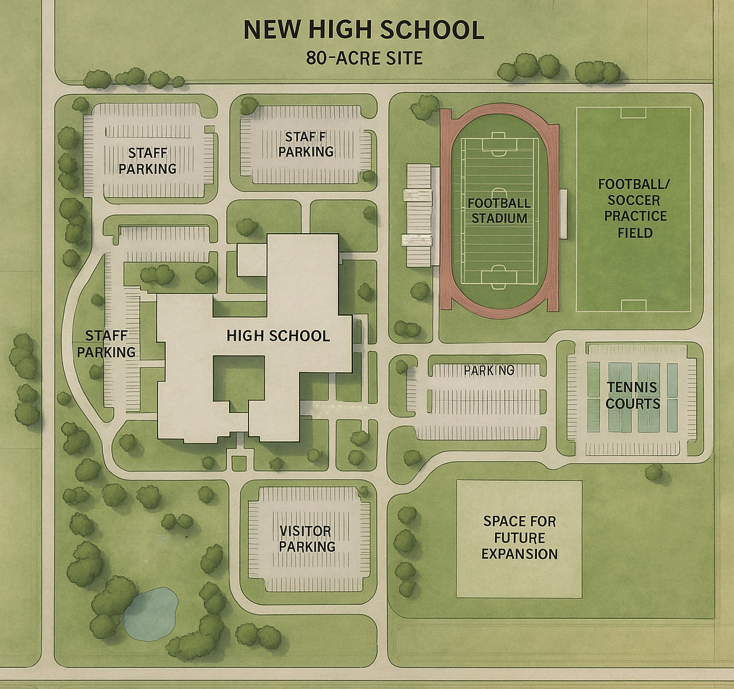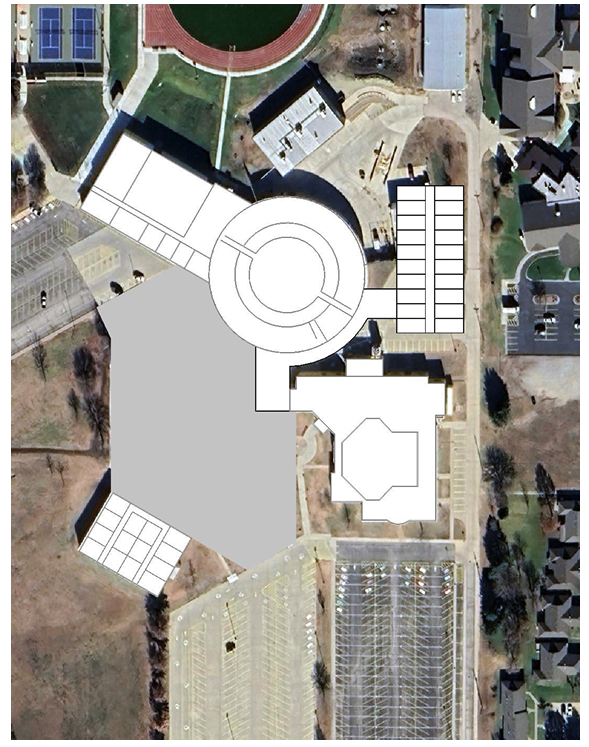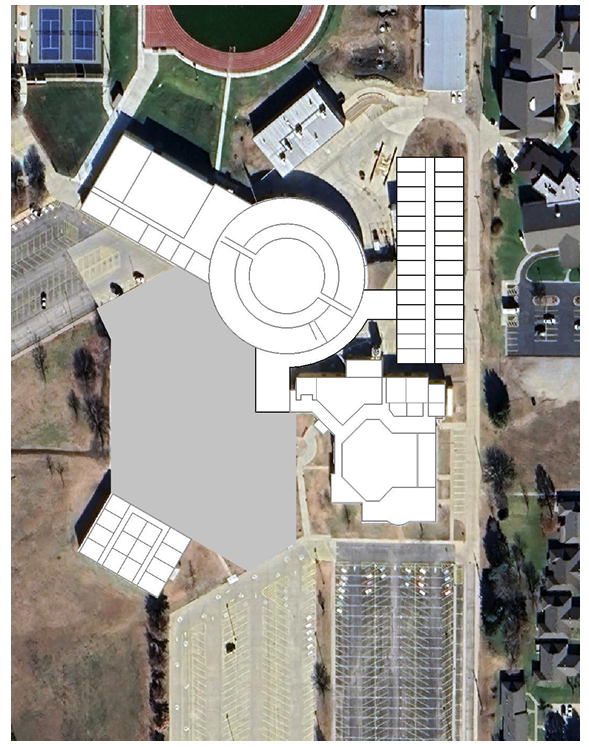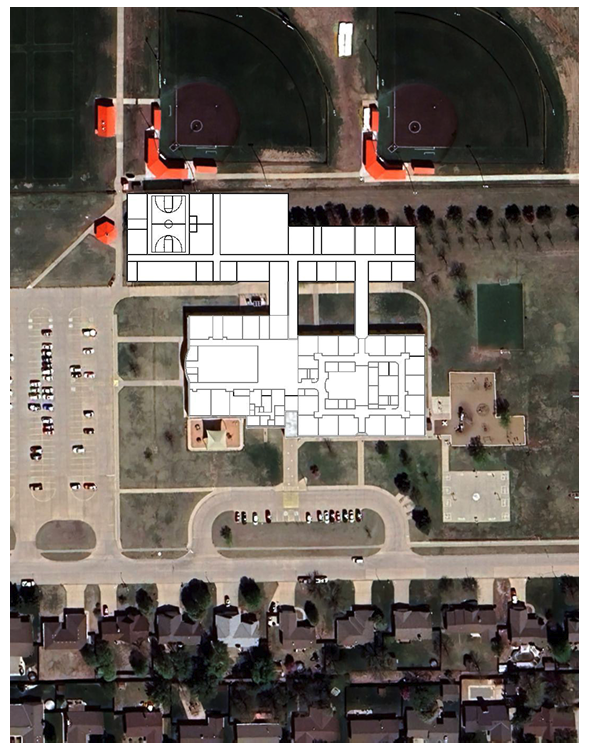2025 Long Range Facility Planning
Option 1
Option 1 - New HS at New Site, MS Moves to HS site
| Elementary Schools | Budget |
| Consolidate to 3 Elementary Schools |
$12M - $14M
|
|
|
|
| Middle School | Budget |
| Move Middle School to High School Site |
$45M - $48M
|
|
|
|
| High School | Budget |
| Build a New High School on a New Site |
$104M - $108M
|
|
|
|
|
Total Potential Cost |
$161M - $170M
|
| Monthly Impact ($200,000 home) |
$39.00 - $41.00
|
NEW HIGH SCHOOL ON A NEW SITE - PROS
- Purpose-built for next-generation learning; flexible, efficient and secure

- Allows full alignment of academics, athletics and fine arts on campus
- No disruption to existing instruction during construction
- Opportunity to select a site with better access, parking and long-termexpansion.
- Establishes a strong new community identity for the next 50+ years
- Existing high school can be repurposed for middle school, maximizing reuse.
NEW HIGH SCHOOL ON A NEW SITE - CONS
- Highest upfront cost and longest timeline.
- Requires land acquisition and new site.
- Moves the high school away from it established community location.
- May increase transportation distances for some families.
- Initial adjustment period for students and alumni who value tradition.
EXISTING HIGH SCHOOL AS A MIDDLE SCHOOL - PROS
 Efficient reuse of a large, structurally sound building with gyms, performance space, and infrastructure already in place.
Efficient reuse of a large, structurally sound building with gyms, performance space, and infrastructure already in place. - Maintains central location for middle school students.
- Avoids need for immediate new construction beyond selective interior renovation.
- Allows for continued use of the Roundhouse and shared facilities districtwide.
- The building would be larger than a middle school needs, leading to operational inefficiencies.
- Because the areas that must be replaced (Hexagon) are the same ones a middle school would use, a substantial rebuild would still be required.
- The layout is not purpose-built for younger learners, creating size and adjacency challenges.
- Limited opportunity to right-size the facility without costly demolition and reconstruction.
Option 1 FAQ
-
- This is to be determined - no site has been targeted at this time.
-
- No. The budget allocated to the transition would ensure that the site will take care of the major issues in the building, including removing the most problematic parts (the hexegons).
-
- The Roundhouse will be preserved and highlighted with this option, and it will continue to be used for activities at the middle school.
-
- This building would transition to no longer being owned by McPherson Public Schools but the exact future of it is unknown at this point.
- This building would transition to no longer being owned by McPherson Public Schools but the exact future of it is unknown at this point.
-
- The "B" building at the current high school site was an addition and is still in great condition, so it would be preserved separately from the middle school for use as offices or another program.
Option 2 - Rennovate and Renew HS at current Site, MS Moves to Eisenhower Site
| Elementary Schools | Budget |
| Consolidate to 3 Elementary Schools |
$12M - $14M
|
|
|
|
| Middle School | Budget |
| Move Middle School to Eisenhower Site |
$37 - $40M
|
|
|
|
| High School | Budget |
| Rennovate and Renew Existing HS |
$49M- $52M
|
|
|
|
|
Total Potential Cost |
$95M - $105M
|
| Monthly Impact ($200,000 home) |
$16.00 - $20.13
|
Rennovate and Renew Existing HS - PROS
- Retains the high school's central location and community identity.

- Targets investment to areas that need it most - aging core academic wings - while preserving high-quality areas like the Fine and Performing Arts wing, which is in excellent shape.
- Opportunity to create a new front entrance, modern commons, and secure entry sequence
- Maintains existing, well-loved facilities such as the Roundhouse, stadium and auditorium
- More cost-effective than building entirely new.
- Construction would occur while the building remains occupied, disrupting learning
- Existing site constraints make circulation and parking improvements limited.
- Campus layout will always be a hybrid of old and new construction
- Some infrastructure and systems will remain legacy components.
- Less flexibility for long-term growth compared to a new site.
Convert Eisenhower Elementary School to a Middle School - PROS
- Reuses an existing district facility, reducing cost and extending the building's useful life.
- Opportunity for a new addition with modern science, CTE, and performance spaces

- Compact campus supports small learning communities (6-8 or 5-8).
- Athletic facilities at the Grant complex could be leveraged through a partnership, providing access to existing fields and amenities rather than duplicating costs
- Smaller campus supports more personal, middle-level environments.
Convert Eisenhower Elementary School to a Middle School - CONS
- Site is limited in expansion potential.
- Requires a significant addition for gym, locker rooms, and specialized programs.
- Off-site athletic access (via Grant complex) will require scheduling coordination
- Some inefficiencies from adapting an elementary layout to middle-level needs.
Option 2 FAQ
-
- The Board will work with district leadership to review community feedback and make a plan about what is best for student learning.
-
- The Roundhouse will be preserved and highlighted with this option and it will continue to be used for activities.
- The Roundhouse will be preserved and highlighted with this option and it will continue to be used for activities.
-
- The most problematic parts (the hexagons) will be removed and a new academic wing will be built. The existing portions of the building will be brought up to a modern standard and tied in to the new portion. Simply put, it will feel like a new building, but make use of the existing assets such as the performing arts wing and competitive gym.
- The most problematic parts (the hexagons) will be removed and a new academic wing will be built. The existing portions of the building will be brought up to a modern standard and tied in to the new portion. Simply put, it will feel like a new building, but make use of the existing assets such as the performing arts wing and competitive gym.
-
- The "B" building at the current high school site was an addition and is still in great condition, so it would be preserved separately from the high school for use as offices or another program.
- The "B" building at the current high school site was an addition and is still in great condition, so it would be preserved separately from the high school for use as offices or another program.
-
- This building would transition to no longer being owned by McPherson Public Schools but the exact future of it is unknown at this point.
Option 3
This plan invests $50 million in the district's highest-priority needs - without increasing the current tax rate. It represents Phase 1 of a long-range facilities strategy that balances fiscal responsibility, educational improvement, and community impact.
|
High School - Modernization and Renewal |
| Scaled back renovation and replacement of core learning environments in the oldest part of the high school |
| Address some mechanical, electrical and plumbing systems at the end of life |
| Upgrade safety, security and ADA accessibility |
| Preserve high-performing areas such as Fine & Performing Arts Wing and Roundhouse |
| Rework front entry sequence for improved circulation, identity and security |
| Elementary Schools - District-Wide Safety Upgrades |
| New secure entry vestibules and controlled access systems |
| Door hardware, cameras, intercoms, and lighting upgrades |
| Selective interior finish updates to extend building life |
| Focused HVAC or roofing replacements where most needed |
| District Operations and Maintenance |
| Replace aging Park and bus barn facilities with a new maintenance/warehouse/transportation building on the existing bus barn property or new acquisition, pending evaluation. |
| Consolidate operations to improve efficiency and reduce long-term costs. |
|
Total Potential Cost |
$50M
|
| Monthly Impact ($200,000 home) |
$0/Month
|
PROS
- No tax increase to local property owners.
- Addresses critical facility and safety needs immediately.
- Extends life and value of existing assets.
- Builds momentum and trust toward a comprehensive future bond.
- Keeps options open for a future projects when community readiness increases.
CONS
- Deferring larger improvements will increase future costs.
- Future phases will still require a tax increase to complete remaining projects.
- The existing middle school's major facility issues remain unaddressed.
- Storm shelters would not be provided at every building
- An empty elementary school would result from consolidation, requiring decisions on reuse, sale, or interim occupancy.
- Some long-term efficiencies and educational benefits will be delayed until later phases.
- Ongoing maintenance costs continue for buildings awaiting future replacement.
Option 3 FAQ
- No. If the community and Board determine this is the best option, more work would be done to determine the best way to use those funds.
- The district is paying off an existing bond several years early, which means the community can opt to continue the same tax rate (millage rate) and allow the district to invest those funds into this project. It would be a new bond that continues the existing tax rate.
General FAQ
-
- These options are a result of extensive work by the Board of Education, Community Long Range Facility Planning Committee and architecture partner, incite Design Studio (iDS). Before the start of this process, the district commissioned RSP Associates to conduct an enrollment and utilization study, which you can find below. That study informed the work. The Facility Planning Timeline is also included below.
- These options are a result of extensive work by the Board of Education, Community Long Range Facility Planning Committee and architecture partner, incite Design Studio (iDS). Before the start of this process, the district commissioned RSP Associates to conduct an enrollment and utilization study, which you can find below. That study informed the work. The Facility Planning Timeline is also included below.
-
- iDS has taken the past few months to listen to community members, board members, district leadership, staff, families and others to understand what might be a workable path and has put together these options based on that feedback.
Elementary FAQ
-
- The enrollment and utilization report from RSP clearly shows a decline in enrollment and under-utilization of our buildings. A shift to 3 elementaries will allow us to more effectively support students by increasing access to shared resources and staff and also ensure equity in class sizes across the district.
- The enrollment and utilization report from RSP clearly shows a decline in enrollment and under-utilization of our buildings. A shift to 3 elementaries will allow us to more effectively support students by increasing access to shared resources and staff and also ensure equity in class sizes across the district.
-
- No, decisions about school configuration (including the number of elementary buildings) are made by the local Board of Education with guidance from district leadership. The long-range facility plan will help inform those conversations, but it does not determine future decisions on its own.
- No, decisions about school configuration (including the number of elementary buildings) are made by the local Board of Education with guidance from district leadership. The long-range facility plan will help inform those conversations, but it does not determine future decisions on its own.
-
- This has not yet been decided and will be determined by the bigger plan.
- This has not yet been decided and will be determined by the bigger plan.
-
- No. The use of functional capacity to set occupancy means that classes will be sized appropriately and more consistently, but not over-sized.
-
-
- Staffing changes will be made through attrition.
-
Long-Range Facility Plan Timeline